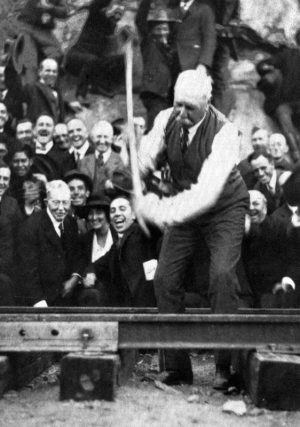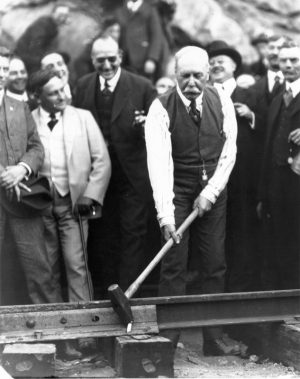99 years ago today, on Nov. 15, 1919, San Diegans began traveling eastbound aboard the San Diego & Arizona Railway; Year-long, 100-year anniversary celebration has been launched by the Pacific Southwest Railway Museum Association
San Diego CA— Beginning today, Thursday, Nov. 15, 2018, the Pacific Southwest Railway Museum Association (PSRM), a historical and educational nonprofit based in Campo, Calif., will launch a year-long, 100-year anniversary celebration of the Nov. 15, 1919 completion of the San Diego & Arizona Railway.

Leading up to a reenactment ceremony at PSRM’s Campo Railroad Park and Museum on Saturday Nov. 16, 2019, museum officials said centennial activities over the next year will include free lectures at public libraries and community groups, special events with other local historical organizations, a groundbreaking festival and presentation of silent movies with chase scenes showing the San Diego & Arizona Railway. Free lectures by volunteers and loan of a traveling exhibit can be requested by visiting the PSRM website, www.psrm.org.
“We’re very excited about kicking-off our year-long celebration and the leading up to the 100 anniversary of the country’s final transcontinental railroad,” said Diana Hyatt, president, PSRM. “We invite all San Diego residents to join the celebration.”
Predominantly financed by entrepreneur John D. Spreckels at a cost of $18 million, or roughly $123,000 per mile, the rail line was called the “Impossible Railroad” by engineers of its day due to the immense logistical challenges, which included extreme terrain requiring 2.5 miles of bridges and trestles and 21 tunnels, including 11 miles through the treacherous Carrizo Gorge, an area where cliffs dropped more than 1,000 feet to the bottom (17 of the 21 tunnels were located in Carrizo Gorge). Additional construction challenges included floods, landslides, fires, hot weather, deaths from the flu, sabotage by Mexican revolutionaries and various delays caused by World War I.
Stretching 148 miles from San Diego to El Centro, the San Diego & Arizona Railway included 44 miles in Mexico and took 12 years to complete. On Nov. 15, 1919, Spreckels himself drove the final “golden spike,” which he accidentally bent at a ceremony held at Carrizo Gorge, 35 miles east of Campo in Anza Borrego Desert State Park, attended by an estimated crowd of 1,000 people, including dignitaries, city officials and residents from San Diego and Imperial Valley. Photos show the crowd laughing at the bent iron railway spike, which was plated with gold.

The completion of San Diego & Arizona Railway established a direct transcontinental rail link to the east by connecting with the Southern Pacific Railroad in El Centro. Previously, San Diegans had to travel north to Los Angeles to connect with an east-bound train. The line is still partially in use today for vintage train rides and by three freight operators.
The Pacific Southwest Railway Museum Association (PSRM) is a non-profit educational organization dedicated to the preservation and interpretation of railroads as they existed in the Pacific Southwest. With more than 120 pieces of equipment and artifacts on display between two facilities in Campo and La Mesa, PSRM provides a unique learning experience for all ages. In Campo, visitors can enjoy vintage train rides aboard locomotives and cars from the early 20th century that are operated by all-volunteer train crews and support staff.







